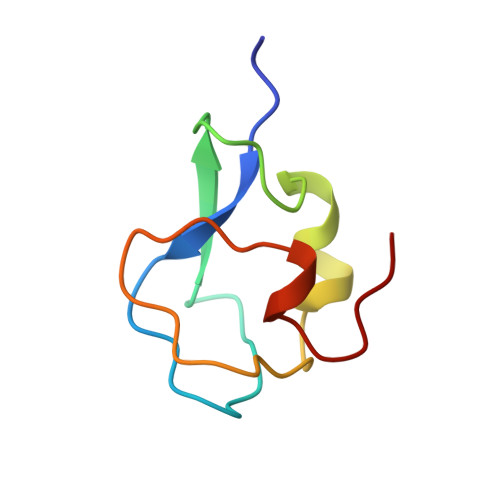Quantitative and qualitative analysis of type III antifreeze protein structure and function.
Graether, S.P., DeLuca, C.I., Baardsnes, J., Hill, G.A., Davies, P.L., Jia, Z.(1999) J Biol Chem 274: 11842-11847
- PubMed: 10207002
- DOI: https://doi.org/10.1074/jbc.274.17.11842
- Primary Citation of Related Structures:
1B7I, 1B7J, 1B7K, 1EKL, 1JAB, 1MSJ, 2AME, 2JIA, 2MSJ, 2SPG, 3AME, 4AME, 6AME, 7AME, 8AME, 8MSI, 9AME, 9MSI - PubMed Abstract:
Some cold water marine fishes avoid cellular damage because of freezing by expressing antifreeze proteins (AFPs) that bind to ice and inhibit its growth; one such protein is the globular type III AFP from eel pout. Despite several studies, the mechanism of ice binding remains unclear because of the difficulty in modeling the AFP-ice interaction. To further explore the mechanism, we have determined the x-ray crystallographic structure of 10 type III AFP mutants and combined that information with 7 previously determined structures to mainly analyze specific AFP-ice interactions such as hydrogen bonds. Quantitative assessment of binding was performed using a neural network with properties of the structure as input and predicted antifreeze activity as output. Using the cross-validation method, a correlation coefficient of 0.60 was obtained between measured and predicted activity, indicating successful learning and good predictive power. A large loss in the predictive power of the neural network occurred after properties related to the hydrophobic surface were left out, suggesting that van der Waal's interactions make a significant contribution to ice binding. By combining the analysis of the neural network with antifreeze activity and x-ray crystallographic structures of the mutants, we extend the existing ice-binding model to a two-step process: 1) probing of the surface for the correct ice-binding plane by hydrogen-bonding side chains and 2) attractive van der Waal's interactions between the other residues of the ice-binding surface and the ice, which increases the strength of the protein-ice interaction.
Organizational Affiliation:
Department of Biochemistry, Queen's University, Kingston, Ontario, K7L 3N6 Canada.














